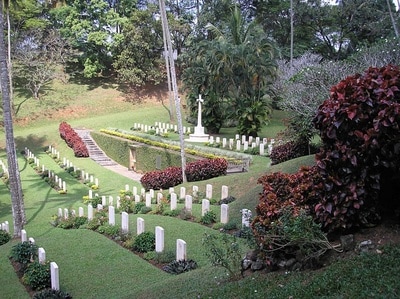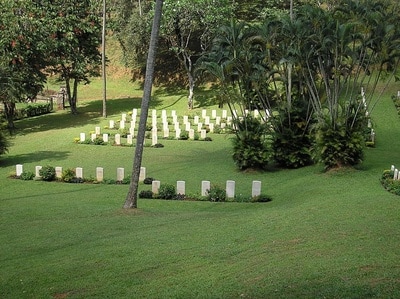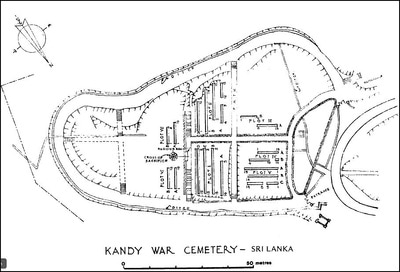KANDY WAR CEMETERY
Kandy
Sri Lanka
Location Information
Kandy is in central Sri Lanka, 910 metres above sea-level. It is 121 kilometres north-east of Colombo, from which it is easily reached by road.
From the Botanical Gardens at Peridenya, take the road to Kandy. Just past the gardens continue over a traffic island and take the next left at the CWGC signpost down Lady Magdalene Drive. The Cemetery is approximately 1.5 kilometres along this road.
Visiting Information
Before considering a visit to Sri Lanka the Commission strongly recommends that you check the advice given by the Foreign & Commonwealth Office on the travel section of their website:
www.fco.gov.uk/en/travel-and-living-abroad/travel-advice-by-country/.
Kandy War Cemetery is open every day between 07:00-16:00. Outside of these hours the cemetery is locked. Wheelchair access is possible via the main entrance.
Historical Information
Formerly known as Pitakande Military Cemetery, it was acquired originally by the military authorities, and was subsequently taken over by the Commission as a permanent war cemetery.
The Army Graves Service transferred to this cemetery service war graves from Divatalawa Boer Military Cemetery; (including graves which had previously been moved from Divatalawa Camp Cemetery and Diyakaduwa Cemetery and from Bandarawala in the Punjab); Galkissa General Cemetery; Ihala Vitiyala Burial Ground; Kandy Civil Cemetery; Kollonawa Burial Ground; Kotagala Forest Creek Cemetery; Mahaiyawa Cemetery; Murugampola Cemetery; Rawatawatte General Cemetery, Moratura; Tibotugoda Etakorasa Cemetery and Trincomalee Hindu and Buddhist Cemetery.
The Special Memorial commemorates a naval man known to have been buried in the cemetery but whose grave could not be precisely located. It bears the superscription "Buried near this spot". There is 1 Commonwealth burial of the 1914-1918 war and a further 196 Commonwealth burials of the 1939-1945 war commemorated here. In addition there are 4 Foreign National and 2 non world war burials.
Cemetery pictures used with the permission of the Commonwealth War Graves Commission
Kandy is in central Sri Lanka, 910 metres above sea-level. It is 121 kilometres north-east of Colombo, from which it is easily reached by road.
From the Botanical Gardens at Peridenya, take the road to Kandy. Just past the gardens continue over a traffic island and take the next left at the CWGC signpost down Lady Magdalene Drive. The Cemetery is approximately 1.5 kilometres along this road.
Visiting Information
Before considering a visit to Sri Lanka the Commission strongly recommends that you check the advice given by the Foreign & Commonwealth Office on the travel section of their website:
www.fco.gov.uk/en/travel-and-living-abroad/travel-advice-by-country/.
Kandy War Cemetery is open every day between 07:00-16:00. Outside of these hours the cemetery is locked. Wheelchair access is possible via the main entrance.
Historical Information
Formerly known as Pitakande Military Cemetery, it was acquired originally by the military authorities, and was subsequently taken over by the Commission as a permanent war cemetery.
The Army Graves Service transferred to this cemetery service war graves from Divatalawa Boer Military Cemetery; (including graves which had previously been moved from Divatalawa Camp Cemetery and Diyakaduwa Cemetery and from Bandarawala in the Punjab); Galkissa General Cemetery; Ihala Vitiyala Burial Ground; Kandy Civil Cemetery; Kollonawa Burial Ground; Kotagala Forest Creek Cemetery; Mahaiyawa Cemetery; Murugampola Cemetery; Rawatawatte General Cemetery, Moratura; Tibotugoda Etakorasa Cemetery and Trincomalee Hindu and Buddhist Cemetery.
The Special Memorial commemorates a naval man known to have been buried in the cemetery but whose grave could not be precisely located. It bears the superscription "Buried near this spot". There is 1 Commonwealth burial of the 1914-1918 war and a further 196 Commonwealth burials of the 1939-1945 war commemorated here. In addition there are 4 Foreign National and 2 non world war burials.
Cemetery pictures used with the permission of the Commonwealth War Graves Commission









